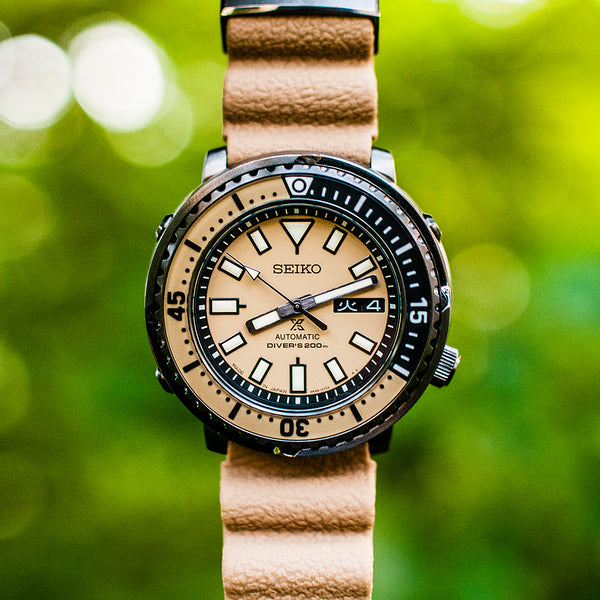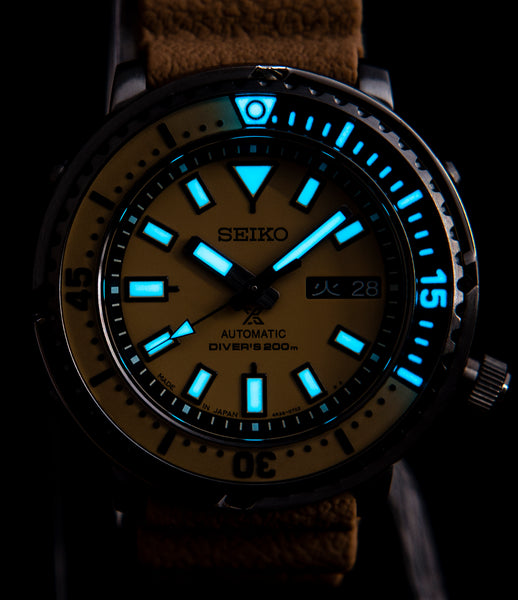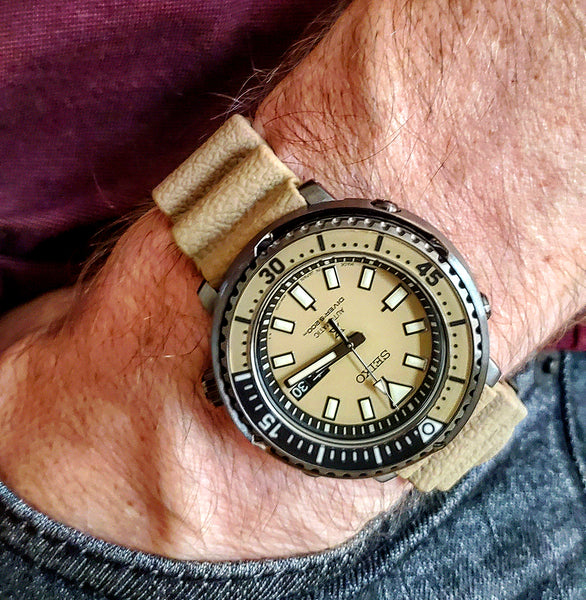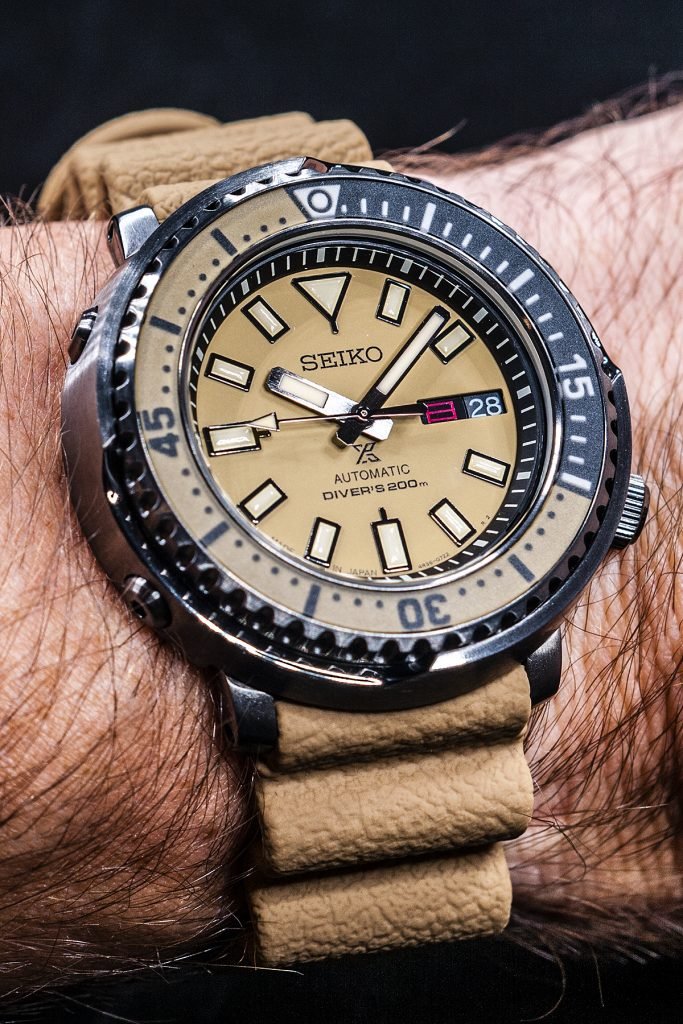If you're a watch geek, and especially if you're a Seiko geek, you're no doubt familiar with the "Tuna." And chances are, if you know the Tuna, you either love the Tuna, or hate the Tuna. You'll find me squarely in the former camp.
If you're not familiar, Tuna is the nickname originally given to Seiko reference 6159-7010 by Seiko fans (as they are wont to do for any iconic Seiko diver). The Tuna nickname comes from the fact that a metal shroud protects the case and bezel of the watch, giving it the shape of a can of tuna (for more on the history, see the links at the end of the article).
The true Tuna has a lugless design, and a unique monocoque case construction (also used on the MM300), and a true Tuna is quite expensive. If you're willing to fudge a bit, Seiko offers a Tuna-like watch for any budget. Most fans refer to any Seiko with a shroud as a Tuna with an additional descriptor (Kinetic Tuna, Baby Tuna, Darth Tuna, etc.).
In 2018, Seiko released the "Street Series" Solar models in a handful of unique colors (SNE533, SNE535 and SNE537). Because these models featured shrouds, they fell into the Tuna category, and I loved the unique colors. I nearly bought the gray SNE537 model numerous times, but I kept wishing Seiko would produce it with an automatic movement.
Earlier this year, I got my wish, and Seiko released the Street Series "Safari" models with automatic movements! Not to long after they hit the market, I ordered a Japanese market version of the tan color (ref# SBDY059, or SRPE29K1 for US markets). They are also available in gray (SBDY061/SRPE31K1). The main difference that I'm aware is that the Japan models have an English/Japanese day wheel versus English/Spanish on the US models, and "Made in Japan" markings on the dial. I've noticed nicer bezel operation on Japan models vs. export in the past, but I didn't have a US model to compare here.
First Impressions
If you missed my unboxing video on Instagram, this thing looks cool from the second it comes out of the box. If the Tuna shape wasn't polarizing enough, the color will definitely divide people. A few of my watch friends accused me of buying a fashion watch. "Umm, that's not really my style" they said, but I went for it anyway.

Beyond that, there are a few unique touches that I have not seen on a Seiko dive watch before. Did it hold up to the Prospex reputation, or did Seiko put form before function? Keep reading to find out!

Case
You don't see much of the case on a Seiko Tuna, so I'll include the shroud in this section. As is common with most Tunas, the shroud is attached to the case by three round bolts. The crown protrudes at 4 o'clock where the fourth bolt would be.

Unlike the colored plastic shrouds on the solar Street Series Tunas, the shrouds on the automatic versions are made of stainless steel. The entire shroud, case and crown are coated in a dark gumetal gray color that Seiko describes only as "Hard Coating."

The shroud is raised in 15 minute segments to provide additional protection to the bezel, but also give space for the wearer to grip and rotate it. It has a slightly conical shape that is thicker at the base, and thins out towards the bezel.

The shroud features mostly a brushed finish that run around the circumference and top of the shroud. The cut out areas of the shroud feature a polished gray finish, however.

Unlike the "real" Tunas with their monocoque cases, the Safari has small lugs that protrude from under the shroud. This makes the watch slightly less compact, but the lug to lug distance is only 0.8mm longer than the case diameter (43.2 diameter vs 44mm lug width). The result (as with all Tunas) is a big watch that will not overhang a smaller wrist, and great wearability for a watch of this diameter.

At 12.7mm thick, no one will mistake this with a dress watch, but that dimension is not overly thick for a beefy dive watch.

Another area where the Safari falls behind "real" Tunas is its water resistance. While current Tuna models can go up to 1000m deep, the Safari can is only rated to submerge 200m. Considering the Safari is about 25% of the cost of a Tuna (and the actual use that most of these will see), 200m is completely appropriate.

As it has a more conventional case design, the Safari does have a traditional screw case-back. That part of the watch is in uncoated stainless. It features the typical mixture of machined and polished finishes, with a polished tsunami logo, and the main specs of the watch.


Bezel
It wasn't until I started seeing non-press photos of the Safari that I noticed that the bezel has some unique characteristics. The bezel insert is translucent with the markings inlaid underneath, rather than painted over aluminum. This is the first of its kind I've seen from a Seiko diver. It is a welcome addition to their repertoire, and works especially well with this unique colorway.
I could not find the material listed anywhere, but it appears to be Seiko's Hardlex mineral crystal, albeit with a matte finish. That should make it more resistant to scratches than traditional Seiko metal bezel inserts.

Additionally, the markers from zero to twenty minutes are luminous! That section has white markers on a black background The rest of the bezel is tan in color with black numerals and minute markings (the minutes are marked with numerals on the fifteens). the lume color and brightness matches that of the dial (more on that later). Usually if a manufacturer lumes a bezel, they lume the whole thing, but this combination looks fun at night. Additionally, I'm not a diver, but I expect this lume pattern would be easier to use when diving in murky water, as it highlights the critical portion. Think of it as the night version of many dive bezels that highlight the first 15 or 20 minutes in a bright color during the daylight (i.e. the Seiko SKX009 "Pepsi" bezel).

The uni-directional 120 click bezel action does not feel or sound particularly precise, but is appropriate for the price range. If you've handled a Turtle, Monster or other affordable Seiko diver, you'll know the feeling. The bezel is quite easy to grip though, due to the sharp ridges around the edge. It is the same dark gray color as the case, also with a brushed finish.

Crown
The screw-down crown is the typical unsigned Seiko dive watch crown at four o'clock. Flat on the face, with a champher, and ridged edges. As many Seiko have voiced, we'd love to see Seiko start using signed crowns with a Seiko logo, but otherwise I have no complaints. The crown is easy to grip, and never interfered with my wrist.

Dial
The dial is a matte tan with the requisite Seiko text at the top, and Prospex logo plus diver specs below. The hour markers are large rectangles, with gloss black surrounds, the exceptions being a triangle and twelve, and the three o'clock marker being replaced by the day and date (white text over black). The twelve, six and nine markers are larger, and feature small sticks pointing to the center of the dial, which aids legibility.

The safari features an angled black chapter ring with white minute markers. I love the touch of black, which adds a bit of attitude to the dial (as if this watch needed more).

As mentioned, the Japan SBDY059 has "Made in Japan" written on the bottom of the dial, vs. only the movement number on the SRPE29K1 variants.

The markers have thick, glossy application of tan lume which glows greenish blue at night. (same color as monster, or more tan?). The lume does not see quite as shockingly bright as other Seikos, but it was still brighter than most watches, and never left me wondering what time it was.

As mentioned, the Japan version of the Safari features Japanese day display in addition to English. The text is white over a black background, except for Sunday in both languages, which is in red. I'm happy that they went with black for these discs instead of white (although a matching tan background would have been superb).

Hands
I like the design of the hands much better on the automatic Street Series Tunas compared to the solar models. The rectangles look more upscale compared to the monster-style broad-arrow hour hand and missile minute hand on the lower-cost models.

The hands are finished in the same gray color as the case, and feature a brushed finish. the seconds hand has an arrow tip. I just wish Seiko had stuck with the rectangle motif when designing the lume on the seconds hand as it would be more cohesive design. All of the hands sometimes appear black, and sometimes very light gray depending on the light.

Normally it bothers me when a minute hand doesn't reach all the way to the chapter ring, but in the case of the chunky, squared-off design used here, I think it looks appropriate to stop just shy.

The lume matches the tan of the hour markers. It does not pop out from the dial like on darker dial watches, but legibility is still very good due to the dark surrounds.

Crystal
There is not much to report about the crystal if you have owned other Seiko divers. It is the typical flat Hardlex (mineral) crystal that you find on many other Seikos.

This watch is into the price range where I expect a sapphire crystal, but Hardlex is not obviously a deal-breaker for me. It is flat, and has minimal glare, but it might be a good candidate for a modification at a later date!
Strap
In recent years, Seiko has been moving from a rubber or resin strap and keepers to silicone with metal keepers for its dive straps. The Safari is no exception, and features a matching 20mm tan strap with dark gray keeper and buckle that match the case.

To me, it's a mixed bag. The soft silicone is comfortable, and the waves dig into my wrist less than they did with the old material. I strongly dislike the metal keepers though. They give the watch a more expensive look in photos, but they have sharp edges and can dig into my wrist. Also, they don't hold the strap end securely, and pick up desk diving scratches.

Luckily, this colorway lends itself well to strap swaps, and looks killer on anything with a bit of tan or black in it. Here is a list of some of the straps that would fit and we think look great with this watch.
-Deployant Rubber
-Ribbed Rubber Pass-Through
-Ridge Rubber
-Tropical Rubber
-Premium Sailcloth and Sailcloth Colorway Collection
-Smooth Rubber
-Rubber and Sailcloth Hybrid Straps
-Pro Diver
-Vented Rubber
-Slim Ridge Rubber
-Waffle Rubber
-Elastic
-Seatbelt

Movement
The Safari features the Seiko 4R36 that you'd expect in a mid-range Prospex. It features date and day (as mentioned, my Japanese-market version has a Kanji date wheel), 24 jewels, hacking and hand-winding, and a power reserve of 41 hours.
Conclusion
At the time of this writing, the Urban Safari is not available in the U.S. market. Adjusting for the exchange rate from Japan, the MSRP should be in the mid-$600 range. Street prices right now are in the mid $400 to mid $500 range. That pricing is a bit higher than models in the Seiko lineup with comparable specs (the Monster and Turtle for example), but was worth it to me for the style.
As watch nerds, I think that we often get hung up on tool watches fitting a specific aesthetic. Sometimes its fun to pull back and buy something that just looks damn cool! Even so, the style does not inhibit it from being a good watch. The Safari still has 200m water resistance, good day and night legibility, and should hold up well to any kind of abuse. It is definitely deserving of the Prospex logo.

So who should buy this watch? It has a similar feel to wearing a fun color G-Shock (such as the Casioak that I reviewed recently), but with a higher build quality, and an automatic movement.
It's obviously not for a strict business environment, but if you dress with a little attitude, and are looking for something fun to wear on the weekends (or during a pandemic), you should check out the Safari. I love the size and proportions, and the colors just pop.
And what about my watch nerd friends who made fun of me? After seeing my Safari in person, one of them asked me if I minded if he bought the same watch as me!!!
You can learn more about it at the Seiko Website.
Your Thoughts
Do you like the Safari, or do you prefer more traditional took Seikos? Let us know on the forum!

Additional Information about the History of the Tuna:
https://thespringbar.com/blogs/guides/the-seiko-tuna-collectors-guide/
https://www.60clicks.com/ultimate-seiko-tuna-collectors-guide/
https://www.fratellowatches.com/seiko-tuna-history/


